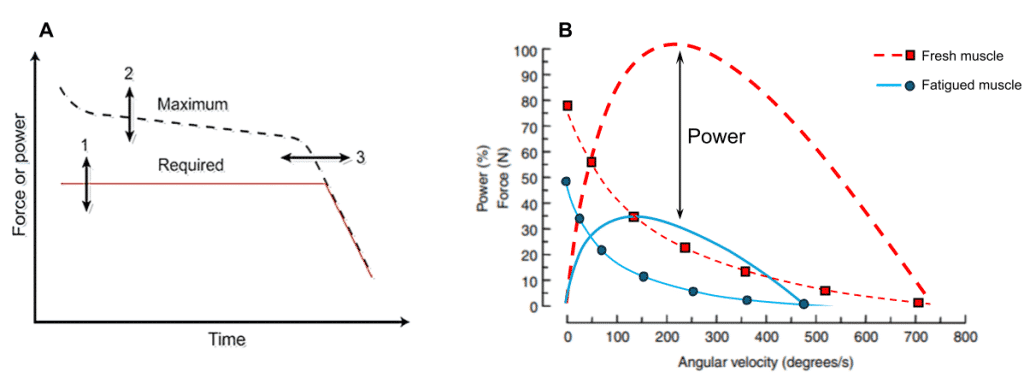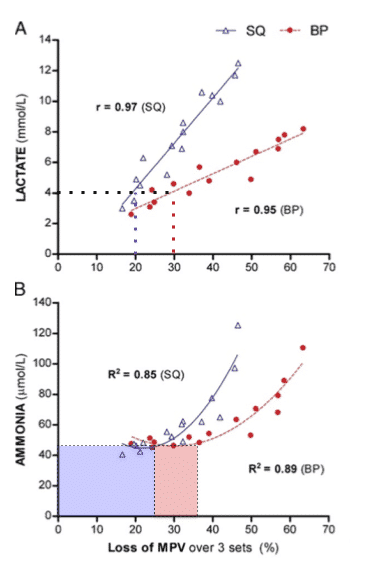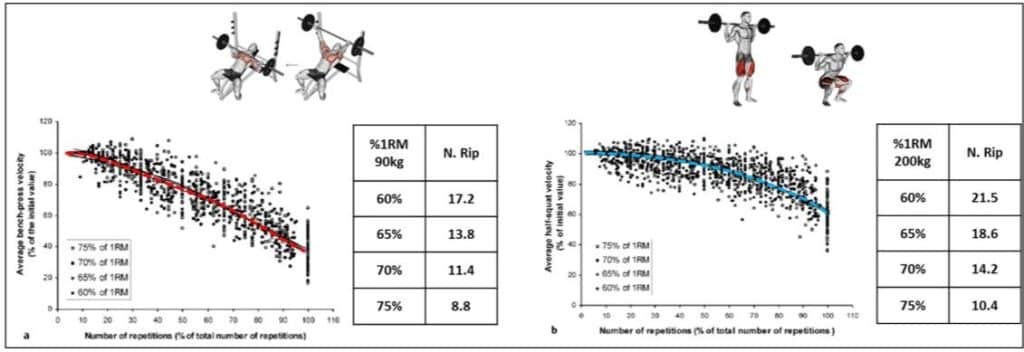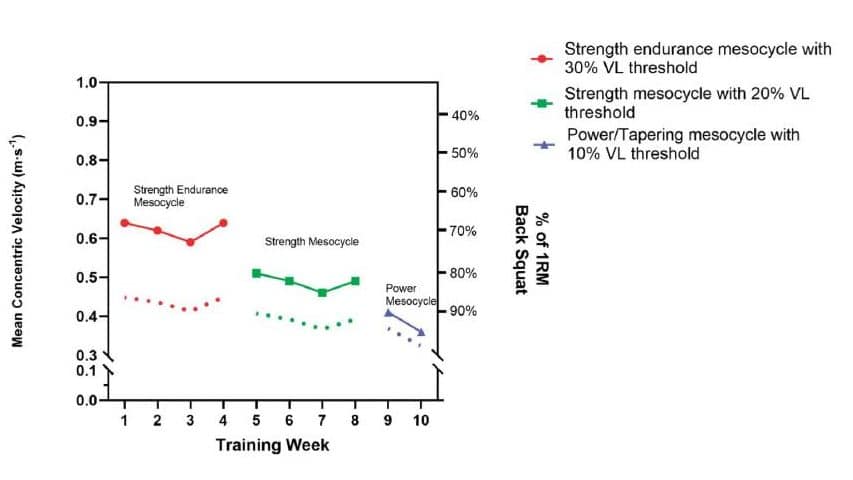19 de September de 2024
Exploring velocity loss: a comprehensive guide for coaches and athletes
To fully grasp velocity loss and achieve optimal results, you must push with maximum intention.
Before examining the relationship between velocity loss and fatigue in resistance training, it is crucial for anyone using the Velocity-Based Training (VBT) method to understand the importance of moving loads at maximum intentional velocity during the concentric phase. It is not uncommon to see athletes in the weight room who don’t put in enough effort to move the loads with maximal intention. This effort is essential and can be enhanced with feedback from a scientifically validated speed monitoring device, such as the Vitruve.
Performing exercises with maximum intentional speed is the foundation of VBT and depends on several factors:
The force-velocity curve, which shows that force and velocity are inversely related, is based on actions performed with maximum contraction or intentional velocity. • Exercises performed with maximum intention lead to stronger adaptations than those performed at lower speeds, particularly in motor unit recruitment and discharge rates, which are key neuromuscular adaptations for maximizing strength and power. • Maximizing the intention to move loads leads to better adaptations in both young and old individuals, indicating that neuromuscular factors are more critical for improving strength and power than muscle hypertrophy.

With these foundational principles in place, we can now explore:
- The link between velocity loss and fatigue.
- The acute and chronic neuromuscular and metabolic adaptations to increased velocity loss during exercise.
- The pattern of velocity loss and the differences between upper and lower limb exercises.
- How to effectively incorporate velocity loss into periodization.
Velocity and Power Loss Due to Fatigue
Among the numerous definitions of fatigue in the literature, the most common element is a decrease in the capacity to generate muscular force, accompanied by an increase in the effort required to perform an exercise until failure. In addition to the decreased ability to generate force, fatigue also slows the maximum velocity of muscle shortening and relaxation. Consequently, force production is affected by the shift in the force-velocity curve, which is one of the primary factors contributing to the loss of muscle power (see Figure 1).

Figure 1:
- A: representation of decay in force and power until exhaustion during a repeated maximum contraction (shaded line). The solid red line represents the submaximal force needed for a specific task. The arrows highlight that the fatigue depends on the task needed in force, the duration to exhaustion vary with changes in the maximum force and muscle fatigability. From D. G. Allen, G. D. Lamb, and H. Westerblad. Physiol Rev 88: 287– 332, 2008.
- B: Force-velocity relationships and power curve of fresh and fatigued muscle. From D.A. Jones. J Physiol. (2010)
In summary, during any strength or power exercise performed with maximal voluntary effort, velocity will inevitably decrease as fatigue increases. Therefore, all definitions of fatigue involve a decrease in both force and velocity (i.e., power).
What Happens When We Lose Velocity?

We all know that when performing 12 maximal squat or bench press repetitions with maximum intention, failure is reached on the twelfth repetition (as with any number of maximal repetitions, e.g., 4, 6, 8, 10). However, by monitoring the set with a Vitruve device, we can see in real time that the first repetition (sometimes even the second) will have the highest average speed, while each subsequent repetition will show a decrease in average speed until reaching the minimum velocity threshold (MVT), which is the average speed that can be measured at 1 RM.
As we perform our set, blood lactate and serum ammonia levels increase in proportion to the rate of velocity loss. The rise in these parameters suggests that muscle metabolism cannot keep up with the demands of the exercise. Lactate levels are directly related to velocity loss, while ammonia levels exhibit a curvilinear relationship, indicating that a certain number of repetitions can be performed before significant fatigue sets in. Regarding lactate, we can hypothesize that, below the famous 4 mmol/L anaerobic threshold, we could work without a significant increase in metabolic fatigue. Therefore, if the goal is not endurance-specific adaptations, stopping earlier may be advisable (see Figure 2).
Figure 2: Relationships between relative loss of mean pro pulsive velocity (MPV) over three sets and peak postexercise: lactate (A) and ammonia (B); SQ: Full Squat; BP: Bench Press. From L. Sanchez-Medina and J.J. Gonzalez Badillo Med & Sci in Sp. & Ex. (2011)
One of the most important scientific studies on the topic (L. Sanchez-Medina and J.J. Gonzalez-Badillo, Med & Sci in Sports & Ex. 2011) showed that the sets producing the highest lactate and ammonia responsors for the squat were: 3 x 12 of 12 Repetitions Maximum (RM), 3 x 10 of 12 RM, 3 x 10 of 10 RM, and 3 x 8 of 8 RM. For the bench press, the highest values were 3 x 8 of 10 max and 3 x 6 of 6 max.
These high values were associated with failure in each set, which is a common protocol for in inducing muscle hypertrophy.
However, when we perform squat or bench press exercises and complete the sets to failure, lactate and ammonia levels increase (as shown in Figure 2) to such an extent that there is not only immediate fatigue but also residual fatigue that affects recovery and performance in subsequent workouts or tasks planned for the following days (as shown by leading scientists in Figure 3).
KNOW MORE: Since de novo nucleotide synthesis, triggered by deamination by IMP and AMP leading to increased ammonia, is a slow and energy-intensive process, muscle performance may remain significantly reduced for up to 48-72 hours after exercise.
The Slower, the Worse
We know that repeated acute adaptations lead to the development of chronic adaptations. In our specific case, performing multiple sessions with significant velocity loss (such as training to failure for eight weeks) produces a series of negative adaptations in performance. Despite increases in maximal force and muscle mass, a transformation of type IIX fibers into type IIA fibers occurs, leading to phenotypic remodeling from fast to slow fibers (as shown by F. Pareja-Blanco et al. in Scand J Med Sci Sports 2017). In practice, a power athlete may increase maximum strength and muscle mass but will experience a slower contraction speed, thereby reducing power.
The False Myth of the “No Pain, No Gain” Approach
Who hasn’t been influenced by the saying “No pain, no gain”? Although this phrase was meant
to convey that results require sacrifice, many athletes and coaches interpret it literally. It is not true that pain after a training session is necessary to achieve improvements. In fact, resistance training sessions with significant velocity loss lead to increased pain (DOMS) and the issues discussed above. In contrast, performing sets within a specified velocity threshold or using a stop velocity allows for the same strength gains as those obtained by performing sets to failure. Additionally, limiting velocity loss during sets can reduce residual fatigue in the following days, preserve fast-twitch fibers, and allow for greater strength gains without excessive muscle mass increase. The remarkable news is that these adaptations can be achieved with up to a 40% reduction in total volume.
Unfortunately, athletes are often assigned a specific number of sets and repetitions (e.g., 5 sets of 4-6- 8 or 10 repetitions) depending on the training goal. However, another important consideration is that the number of repetitions that can be performed at a given % of 1 RM varies from athlete to athlete!
Therefore, assign using the same number of sets and repetitions to all athletes induces different levels of effort and fatigue. To this end, monitoring velocity loss with a Vitruve device is the best and most objective way to guide training in the right direction.
How Does Velocity Drop During a Set?
One of the key questions to address is how much speed should be lost to achieve optimal results.
Loss of repetition velocity can be used as an objective indicator of the extent of neuromuscular fatigue induced by typical resistance training (RT) sessions.
By monitoring repetition velocity during training, it is possible to reasonably estimate the metabolic stress and neuromuscular fatigue induced by resistance exercise.
It’s important to note that the muscles in the upper and lower limbs differ significantly.
Studies by D. Rodriguez-Rosell et al. 2020 and M. Izquierdo et al. 2006 show that, compared to the squat, the bench press exhibits a faster rate of velocity decline (see Figure 3).
For example:
As discussed earlier regarding the increase in lactate and ammonia, a velocity loss of 20- 25% during a squat series corresponds to a velocity loss of approximately 30-35% for the bench press.
Consequently, the velocity thresholds for the lower and upper limbs will be slightly different.

Figure 3: relationship between the average velocity achieved during each repetition and the number of repetitions
performed with different percentages of 1RM in a bench press (A) and parallel squat actions (B). It should be noted that the number of repetitions in a full squat is lower than in a parallel squat. M. Izquierdo et al. Int J Sports Med 2006. D. Rodriguez-Rosell et al. Journal of Strength and Conditioning Research 2020.
🔎KNOW MORE about velocity loss and its relation with fatigue on a set HERE
Research on Velocity Loss Provides Important Key Points
Today, thanks to numerous scientific articles and recent meta-analyses, it is possible to define different velocity loss thresholds depending on the training goal:
• If hypertrophy is the goal during a specific phase of training, it may be appropriate to prescribe a higher number of repetitions close to muscle failure (e.g., 3 x 10 of 12RM) or a velocity loss of 40% and 50% for lower and upper limbs, respectively. However, we must be aware that this type of session can negatively impact performance in subsequent train ing sessions, such as sprints or endurance runs, or other sporting skills. Moreover, as mentioned above, this type of training can result in the loss of fast-twitch fibers, lower explosiveness, and delayed recovery.
• By slightly reducing the velocity loss without reaching failure, there is a marked reduction in fatigue and damage markers (e.g., 3 x 8 or 3 x 6 of 10RM or 30% and 40% velocity loss for lower and upper body, respectively). If minimizing interference with other training sessions is essential, this option may be more manageable, involving less fatigue and damage during resistance training sessions that might interfere with other activities.
• For strength and power training, we should limit velocity loss within a set to a 20% drop for squats and approximately 30% for upper body exercises. In this case, low-repetition and non-fatiguing options (e.g., 3 x 3 of 6RM or 3 x 2 of 4RM) appear to offer a better solution for minimizing fatigue and damage markers while still lifting over 80% 1RM.
This option is ideal for athletes who do not wish to increase muscle mass (e.g., sprinters, jumpers, middle-distance runners) but want to continue improving strength and power with minimal fatigue, especially in-season. Unlike strength exercises, the key parameter for “power” exercises is peak velocity, as this determines performance in any ballistic-type exercise (e.g., clean, jerk, or squat jump).
Consequently, for power exercises, there may not be as significant a drop in speed over several sets compared to strength exercises, and it is recommended not to decrease speed by more than 10% in a set. However, during peaking or tapering, a reduction of 5% may be more appropriate.
Therefore, to maximize power training adaptations, limiting speed loss during power exercises, such as Olympic lifts, jumps, throws, etc., should generally stay within 10% for most sessions and 5% when peaking.
Here are some examples of Velocity Loss Application Using a Vitruve Device:
- Apply a fixed number of sets (e.g., 5 sets) with a flexible repetition pattern (e.g., athletes train to a velocity loss of 20%). This approach does not limit the number of repetitions but matches the effort level.
- Alternatively, prescribe a fixed number of repetitions (e.g., 25 repetitions) with a flexible number of sets, ending when speed is reduced by 20%. This way, athletes perform the number of sets required to complete the 25 repetitions (J. Weakley et al. 2021).
Implementing Velocity Loss in a Specific Periodization Model
For example, in a block periodization model using VBT, the initial phases aimed at improving strength endurance and body composition might utilize speed loss thresholds of 30%. This phase could be followed by a strength mesocycle with higher loads (lower starting velocities) and a lower velocity loss threshold (e.g., 20%), leading to less peripheral fatigue. Finally, this could be followed by a strength or tapering mesocycle using a range of initial starting velocities with a much lower velocity loss threshold (e.g., 10%; see Figure 4). These Concepts can be applied to various programming models (e.g., linear, daily/weekly wave, conjugate) and can help coaches implement traditional approaches with more precision and Control.

Figure 4: Representation of ten-week back squat workout block periodization. The average starting mean concentric velocity for a specific week (e.g., week 1 = 0.64 m/s) is shown by the bullet inside each connected line. The average stop velocity (e.g., week 1 = 0.45 m/s) is shown by the dotted line. Observe that when the intensity rises throughout each mesocycle, the velocity loss threshold falls. VL stands for velocity loss. By J. Weakley et al. Strength and Conditioning Journal 2020
References
1. Amador Garcí a-Ramos, “Resistance Training Intensity Prescription Methods Based on Lifting Velocity Monitoring”, in Int J Sports Med., in 2024; DOI: 10.1055/a-2158-3848
2. David A. Jones, “Changes in the force-velocity relationship of fatigued muscle: implications for power pro duction and possible causes”, in J Physiol., in 2010; DOI: 10.1113/jphysiol.2010.190934
3. David Rodrí guez-Rosell et al., “Relationship Between Velocity Loss and Repetitions in Reserve in the Bench Press and Back Squat Exercises”, in J Strength Cond Res., in 2020; DOI: 10.1519/JSC.0000000000002881
4. Fernando Pareja-Blanco et al., “Velocity Loss as a Critical Variable Determining the Adaptations to Strength Training”, in Med Sci Sports Exerc., in 2020; DOI: 10.1249/MSS.0000000000002295
5. Fernando Pareja-Blanco et al., “Acute and delayed response to resistance exercise leading or not leading to muscle failure”, in Clin Physiol Funct Imaging., in 2017; DOI: 10.1111/cpf.12348
6. Fernando Pareja-Blanco et al., “Effects of velocity loss during resistance training on athletic performance, strength gains and muscle adaptations”, in Scand J Med Sci Sports., in 2017; DOI: 10.1111/sms.12678
7. Ivan Jukic et al., “The Acute and Chronic Effects of Implementing Velocity Loss Thresholds During Re sistance Training: A Systematic Review, Meta-Analysis, and Critical Evaluation of the Literature”, in Sports Med., in 2023; DOI: 10.1007/s40279-022-01754-4
8. Jonathon Weakley et al., “Velocity-Based Training: From Theory to Application”, in Strength and Cond J., in 2021; DOI: 10.1519/SSC.0000000000000560
9. Juan J. Gonza lez-Badillo et al., “Velocity Loss as a Variable for Monitoring Resistance Exercise”, in Int J Sports Med., in 2017; DOI: 10.1055/s-0042-120324
10. Julian Alcazar et al., “Dose-Response Relationship Between Velocity Loss During Resistance Training and Changes in the Squat Force-Velocity Relationship”, in Int J Sports Physiol Perform., in 2021; DOI: 10.1123/ijspp.2020-0692
11. Landyn M. Hickmott et al., “The Effect of Load and Volume Autoregulation on Muscular Strength and Hy pertrophy: A Systematic Review and Meta-Analysis”, in Sports Med Open., in 2022; DOI: 10.1186/s40798- 021-00404-9
12. Luis Sa nchez-Medina and Juan J. Gonza lez-Badillo, “Velocity loss as an indicator of neuromuscular fatigue during resistance training” in Med Sci Sports Exerc., in 2011; DOI: 10.1249/MSS.0b013e318213f880
13. Mikel Izquierdo et al., “Effect of loading on unintentional lifting velocity declines during single sets of rep etitions to failure during upper and lower extremity muscle actions”, in Int J Sports Med., in 2006; DOI: 10.1055/s-2005-872825
